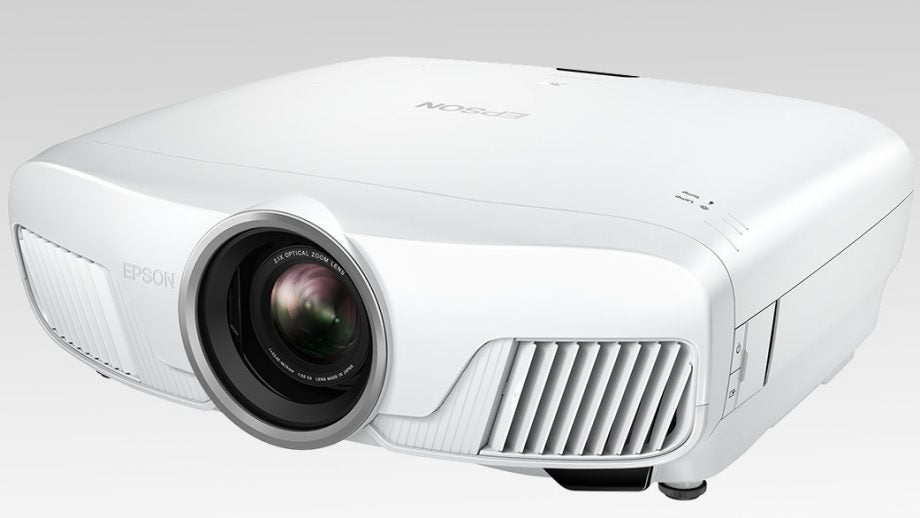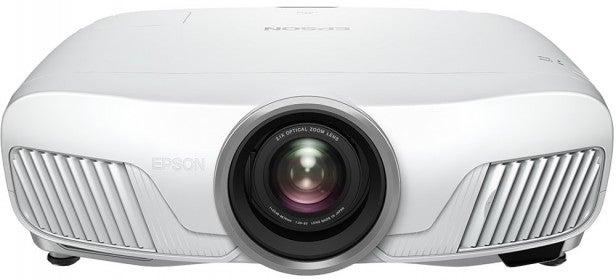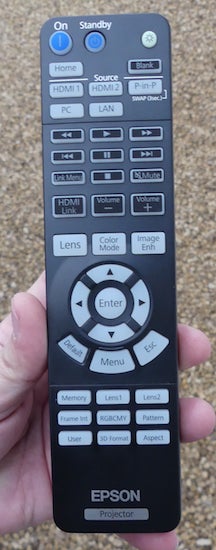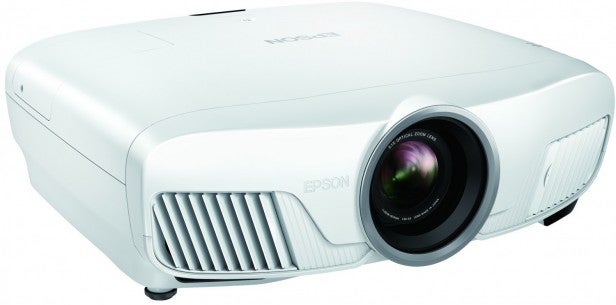Epson EH-TW7300 Review - Picture Quality and Verdict Review
Picture Quality and Verdict
A lot of projector for your money

Sections
- Page 1 Epson EH-TW7300 Review
- Page 2 Picture Quality and Verdict Review
Epson EH-TW7300 – Picture Quality
Since the TW7300’s headline-grabbing feature is its supposed ability to play both 4K and HDR content, I couldn’t resist trying it out first with a few Ultra HD Blu-rays. Unfortunately, despite having a pleasant colour surprise up its sleeve, overall the TW7300 largely lived down to my low HDR expectations.
Let’s look at the good news first, though. The Cinema preset’s colour filter really does do an excellent job of taking on the wider colour spectrum associated with pretty much all HDR content we’re seeing so far.
Without the filter in play, colours with HDR tend to look strained and unnatural. With the filter active, everything from rich blue skies to boldly coloured clothes and subtly lit skin tones instantly looks much more credible, natural and satisfying. In fact, I’d even say the TW7300 delivers HDR colours more effectively than JVC’s more expensive X5000.
There is a limit to the TW7300’s HDR colour potential. The problem is that while the projector’s claimed maximum light output of 2300 lumens is high for a mid-range home cinema unit, it still isn’t enough to render HDR’s expanded luminance range effectively.
The most effective all-round HDR picture settings (as described in the Setup section) result in an image that’s at times distractingly dark. And as well as making the darkest parts of the picture appear too dominant, this darkness means there’s not enough ‘volume’ – the effect of light on colour – to achieve the sort of tonal punch and range that wide-colour-spectrum content thrives on. So while HDR colours look impressively balanced and believable for an affordable projector, they still look rather flat by wider HDR standards.
The other big problem for HDR on the TW7300 is clipping, where details and colour subtleties are ‘bleached out’ of the brightest parts of the image.
Even with the lamp only set to Medium and the HDR mode set to the fairly dark Mode 2 level, bright highlights of the picture suffer with so much clipping that they look like holes ripped from the image. Sadly the much brighter, and in other ways more satisfying, HDR Mode 1 Dynamic Range setting clips so much detail in bright areas that it’s essentially unusable.
As noted in the Setup section, I tried every combination I could think of around the projector’s dynamic range, lamp output and contast options, but nothing gave me a really enjoyable HDR image. Depending on which settings I was using, the image either looked too dull, too grey in dark areas, too gaudily coloured, or too devoid of detail in bright areas.
I didn’t find a single HDR film where I wasn’t fairly routinely distracted by some aspect of the performance, but there are times when the TW7300’s HDR pictures do still look impressive. Bright shots with minimal dark areas and relatively restrained brightness peaks can look rather lovely, and give at least a sense of the extra richness and luminance range of HDR. 
Ultimately, even the impressive colour filter does little to dissuade me that HDR remains beyond the capabilities of any remotely affordable projector. It should probably be ignored when deliberating over which projector you buy unless you’re able to make the financial leap to Sony’s £9k VW550ES.
Take HDR out of the equation and the TW7300 instantly goes from ‘meh’ to ‘yay’. Suddenly pictures look bright, natural, contrast-rich, comfortable and consistent in a way you never got when it was running in HDR mode. Now you can appreciate all of the projector’s strengths rather than finding your eye always being drawn to some area of weakness.
In SDR mode you feel much more acutely aware of how effective the TW7300’s pseudo-4K system is. As with JVC’s ‘e-Shift’ system, the TW7300’s 4K Enhanced mode is no match in terms of raw detail and clarity for a good native 4K projector. But you do get a sense of more detail, finer lines and reduced jaggies than you do when watching the same scenes in HD on a native HD projector.
Even better, the TW7300 delivers this uplift in perceived resolution without generating excessive motion blur or dot-crawl noise.
The brightness of the TW7300’s lamp becomes much more effective with SDR than it does with HDR, helping to propel images off your screen with excellent dynamism for such an affordable projector.
Colours in SDR mode look fantastically natural for the TW7300’s price point, and also enjoy outstanding amounts of blend subtlety. This helps pictures look more three-dimensional and ensures that skin tones never take on that unrefined, plasticky look often seen on affordable projectors.
The TW7300 handles motion exceptionally well for an LCD projector too, delivering it without exaggerated judder, blur or processing side effects – so long as you don’t use the frame-interpolation setting on High.
The most surprising achievement of the TW7300 with SDR content, though, is the depth of black it can deliver – provided you’re running the lamp on low and using the Dynamic Iris system. Black level has traditionally being a weakness of LCD projection systems, but the TW7300 presents dark SDR scenes with authority and without having to sacrifice so much brightness that dark scenes feel flat and lifeless. 
It must be said that the JVC X5000 does even better than the TW7300 where black depth is concerned, and does so without needing to use a dynamic iris. This means the JVC can deliver its inky blacks without sacrificing light output.
The TW7300 is capable of getting slightly brighter than the JVC, though. And it costs barely half as much.
When it comes to running noise, the TW7300 is reasonably quiet in its Low lamp output mode. Noise from the cooling fans becomes much more noticeable in the Medium and especially High lamp modes, though. In these modes the dynamic iris also causes some chuntering that can become distracting if you’re sat near the projector.
Gamers thinking the TW7300 sounds like an excellent big-screen gaming display will be pleased to hear that, with as much processing as I could find turned off and the video-processing mode set to Fast, average input lag measured just over 30ms. A solid result, although this mean figure came from a series of results that varied from as little as 12ms to as high as 52ms.
If you’re still a fan of 3D, the TW7300 is a passable, but far from great, 3D performer. Its 3D images are bright and detailed, and enjoy a strong sense of depth and space thanks to the projector’s strong contrast. But all too often, details and objects in the mid and far distance are left looking soft and indistinct by more crosstalk ghosting noise than I would’ve expected.
Should I buy the Epson EH-TW7300?
Provided you’re sensible about your expectations, the TW7300 can be considered an excellent home cinema projector for the asking price.
Sure, it doesn’t do a great job with HDR. But nor do any projectors I’ve seen for this side of £8,500, and I don’t expect that to change any time soon. The TW7300 does, do an excellent job with SDR and even 4K sources, giving Sony’s £2,800 VPL-HW65ES a run for its money.
JVC’s DLA-X5000 delivers markedly better black levels and a generally more stable image than the TW7300, but it isn’t quite as bright, also fails to convince with HDR, and costs close to four grand.
Since the TW7300 isn’t comfortable with HDR, I’d suggest partnering it with an Xbox One S or Panasonic UB900/UB700 UHD Blu-ray player, as these let you turn off HDR playback at the source, while Samsung’s K8500 UHD BD deck doesn’t.
Related: Best TVs to Buy
Verdict
Despite its inevitable shortcomings with HDR, the TW7300 is a substantial, mostly really successful upgrade on its already illustrious predecessor. Its £2,100 price looks like a steal.
Trusted Score
Score in detail
-
Value 9
-
2D Image Quality 9
-
Features 9
-
3D Image Quality 7
-
Design 8

